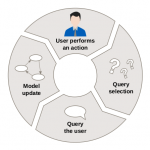Human-Robot Interaction

Service and collaborative robots are becoming more common in dynamic human-inhabited environments. Robots have potentially a wide range of capabilities, making them the perfect candidates for the role of general assistive devices. To be fully effective, robots must adapt to their end users’ needs. Users, however, may lack the technical skills to properly instruct robots to their needs. For this reason, robots should learn from people in a natural yet effective way.
What we do
- Analyse robot learning paradigms like Learning from Demonstration (LfD) and Active Learning (AL) from the Human-Robot Interaction
- Integrate learning techniques into End-User Programming frameworks
Current Projects
Explainable Interactions between Humans and Autonomous Systems
With the growing advancement of robotics research, there is a growing need for people-friendly communication between robots and humans. On one hand, the decisions of the autonomous system need to be understandable to humans, and on the other – humans need to be able to specify commands in a way that is natural to them. […]
Past Projects

Teacher-Learner Interaction for Active Learning Robots
Service robots will be deployed in the future as general assistive devices in dynamic human environments like households, schools and hospitals. In order to be valuable and cost-effective assistants, robots must allow a wide range of customization, especially regarding their skills. As pre-programming robots for every situation is impossible, robots need to gain new skills […]